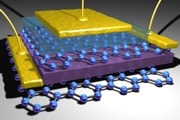Researchers in Australia and the US have demonstrated a working transistor by placing of single atom of phosphorous with atomic precision between gates made of wires only a few phosphorous atoms wide. This demonstration points to possibly extending current computer technology to the atomic scale.
